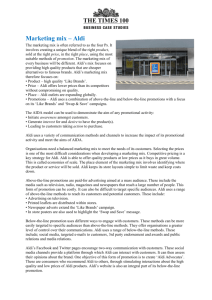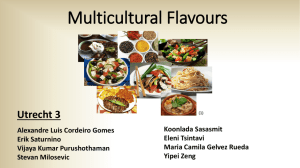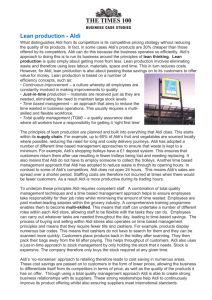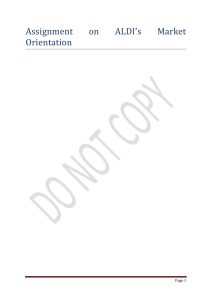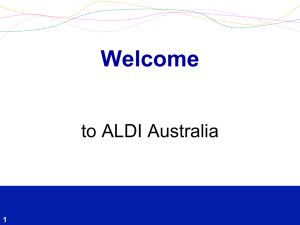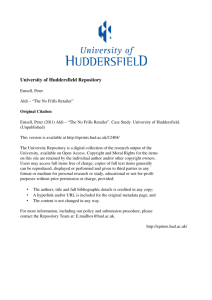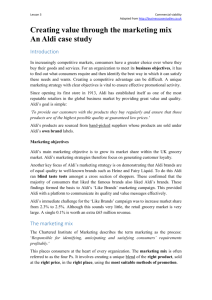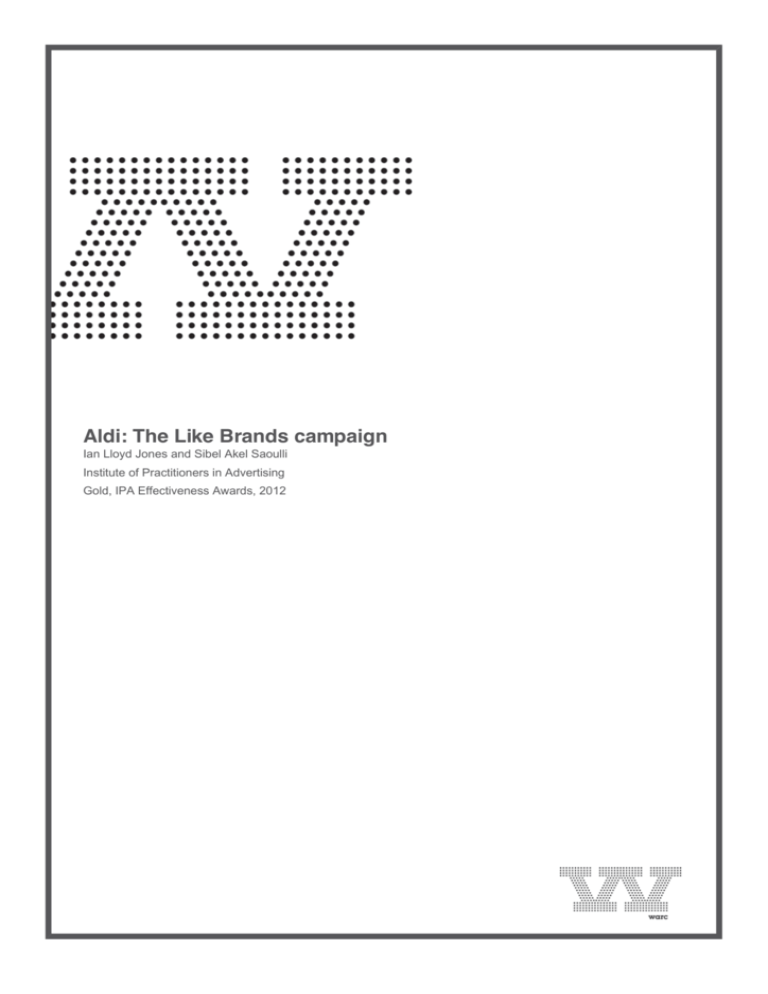
Aldi: The Like Brands campaign
Ian Lloyd Jones and Sibel Akel Saoulli
Institute of Practitioners in Advertising
Gold, IPA Effectiveness Awards, 2012
Aldi: The Like Brands campaign
Ian Lloyd Jones and Sibel Akel Saoulli
Institute of Practitioners in Advertising
Gold, IPA Effectiveness Awards, 2012
Aldi: The Like Brands campaign
Principal authors: Ian Lloyd Jones and Sibel Akel Saoulli, McCann Manchester
This paper tells the story of how an unusual creative communications strategy helped transform Aldi from retail underdog to
fastest growing supermarket chain in the UK, along the way creating the UK's favourite TV ad of 20111.
Martial arts such as Judo and Ju-jitsu are well known for using an opponent's force against them, borrowing and redirecting
their power so that even a stronger attacker can be disarmed. Aldi faced much larger opponents in the Big 4 supermarkets
Tesco, Asda, Sainsbury's and Morrisons
and it was beginning to lose the tussle. Appropriate then, to see if martial arts
thinking could help gain the upper hand in marketing communications against competitors with much greater resources.
The 'Like Brands' campaign was introduced in February 2011, and propelled Aldi's market share growth from a virtual standstill
to +43%2 up on previous year.
This paper will show how the "Like Brands" campaign delivered the biggest sales growth in Aldi's history, by increasing
shopper basket size and frequency of shopper visits.
It will also demonstrate how the whole strategy was fuelled by a deep dive into the hearts and minds of consumers, producing
insights which led to the conclusion that the best prospects for growth lay in an unlikely place
Aldi's most disloyal customers.
CATEGORY CONTEXT
Aldi held an average market value share of just 2.4% in 20103 making it a relatively small player in the UK supermarket sector.
It had to compete for every pound of consumer grocery spending with the Big 4 who together accounted for 3/4 of all grocery
sales4.
Downloaded from warc.com
2
Figure 1: Aldi Market Share vs. the Big 4 Supermarkets
Source: Nielsen Homescan Total FMCG (excluding Non Food)
- 52 week ending 24th December 2010
As the planning cycle commenced in September 2010, the picture was rather bleak. The economic downturn had not benefited
Aldi. Its growth rate had been dropping and whilst some corrective actions had been taken growth remained at a worryingly
low level.
Figure 2: Aldi's Declining Value Share Growth
To the casual observer this weak performance may seem surprising. Surely in recession people make sacrifices and
traditional discounters like Aldi do well? If only it were that simple. Recession had made consumers more risk averse. It had
fundamentally impacted consumer confidence5 and led to them seeking tried & tested brands rather than experimenting with
new ones.
To make things worse, the value for money mantle was being claimed by other supermarkets, and they all enjoyed more
heritage and consumer trust than Aldi. The major supermarkets were all dropping prices and upping promotional spends.
In a direct attack on Aldi, Tesco launched a major campaign claiming to be 'Britain's Biggest Discounter'. As part of this
Downloaded from warc.com
3
initiative it introduced a huge range of new products with names and identities similar to those found in Aldi. In-store these
were supported with shelf edge strips showing that their prices matched those of Aldi. The intended message was clear;
Tesco shoppers did not need to go to Aldi as Tesco matched their offer.
Figure 3: Supermarkets' Focus on Value for Money Messages
A WORD ON THE ALDI BUSINESS MODEL
Aldi does not operate the same way as other supermarkets. First, as supermarkets go, the stores are relatively small.
Constructed around four or five main aisles, all the stores follow the same simple format. Little money is wasted on displays
and signage. Aldi stocks about 1200 product lines; larger supermarkets frequently offer more than 25,000. Most notably, Aldi
doesn't list famous brands preferring to create and sell its own product range at lower prices. In short, Aldi delivers a very
different shopping experience from the one British shoppers are used to.
Figure 4: Aldi Brands vs. Famous & Own Label Brands
Downloaded from warc.com
4
During the recession, these fundamental differences in the way Aldi conducts business had become a bigger barrier. It was
proving difficult to persuade shoppers to adopt the different approach that Aldi offered. To make things worse, the recession
had made consumers more sensitive about being seen shopping at Aldi. Many shoppers thought shopping at Aldi was a sign
of financial desperation and shopping there seemed to add to their feelings of financial hardship.
Figure 5: Negative Perceptions of Aldi
GATHERING CONSUMER INSIGHTS
Aldi management were determined that performance should be improved. We knew that fresh consumer insight
understanding what was affecting consumers' shopping behaviours
really
was the key to unlocking the growth opportunity.
We turned to research to inspire our strategic thinking and designed a deep dive into the hearts and minds of grocery
shoppers. Using a mix of qualitative and quantitative research techniques6 we uncovered three main insights:
1. The majority of Aldi shoppers are highly disloyal
To get the most out of the Nielsen Homescan data we went beyond standard reports and commissioned a special analysis of
shopping patterns. We knew that Aldi was a 'top-up' rather than a 'main shop' for most people but, even so, the results
astonished us:
Over 80% of Aldi shoppers displayed an extremely low loyalty level. Their average visit frequency was just 6 times across
a full year and on average they were giving Aldi just 2% of their grocery spending7.
Around a third of households shopped at Aldi in a full year but Aldi was a 'sometimes' shop for almost all of these (73%)8.
These findings were a total eye-opener. For many, Aldi clearly was a shop they felt they could take or leave. The predominant
pattern was to use Aldi only occasionally and for only a few basic items. A quantification of the business opportunity amongst
high, medium and low loyal Aldi customers was undertaken and this showed clearly that the low loyals offered the greatest
scope for increasing sales.
2. Brands are synonymous with quality
Downloaded from warc.com
5
Focus groups were conducted9 amongst Aldi shoppers and confirmed what we already suspected people believed:
"I can't do a full shop at Aldi because they don't sell the brands I need10".
The surprise was the degree to which this was stopping people from diverting more of their expenditure to Aldi. Consumers, it
seemed, simply could not live without the big name brands, and many claimed that partners and children were more brand
conscious than they were and would reject Aldi products as being inferior. The least loyal Aldi shoppers appeared most
emotionally attached to big name brands.
Further digging led us to a core insight:
Figure 6: Consumer Perception that Low Price means Low Quality and a High Risk Purchase
Aldi's price positioning was clearly understood, but this was not converting into an image of true value for money because Aldi
brands' quality credentials were in question. Cheap prices at Aldi were not simply the same as cheap prices at any of the Big
4. The Aldi brand did not carry the weight of assurance that more established supermarkets like Tesco or Sainsbury's enjoyed.
3. Lack of emotional connection
The final insight was that consumers were emotionally distant from the brand.
Conventional supermarkets offered a much wider range of services
toilets, petrol, reward schemes, home delivery and so on
butchery counters, fishmongers, in-store bakeries, cafes,
which the Aldi business model did not permit. These add-ons made
larger shops feel more welcoming.
Aldi would need to create empathy in other ways
in ways that would give Aldi an authentic voice and make it a strong brand
on a par with the Big 4.
CAMPAIGN STRATEGY
Armed with these insights the next step was to develop a campaign strategy. For each of the three insights we came up with a
strategic response and in this way established a three pillar communications strategy.
Downloaded from warc.com
6
Figure 7: First Strategic Pillar
Given Aldi's tiny market share, the most obvious strategy would have been to chase new customers. However, our deep dive
had revealed that there was an easier target to go for: the vast number of disloyal customers who only occasionally shopped
at Aldi. These disloyal customers made up 80% of Aldi's existing customer base, yet spent around 20bn per year in other
supermarkets, and primarily in the Big4. Diverting a fraction of this to Aldi would deliver much higher growth rates.
We judged that instead of acquiring brand new customers, the 2011 campaign should instead spend its money more wisely
and persuade these disloyal shoppers, who were already familiar with the brand, to spend more at Aldi.
Figure 8: Second Strategic Pillar
We had been hearing repeatedly on our journey:
Consumers were craving the power of big name brands
Heinz, PG Tips, Fairy Liquid etc. These brands stood for quality and
were the missing link for Aldi.
The killer question was, how could we convince our disloyal customers that Aldi brands were of similar quality despite their
significantly lower prices and unknown names?
To help us come up with a solution, we decided to run blind taste tests amongst a cross section of shoppers. Our objective
was to figure out what people really thought of the Aldi brands in the absence of brand cues. Would they think they are as
good as their famous cousins? Would people who liked the famous brands also like the Aldi versions?
To our delight, the tests confirmed that the majority of the people who liked the famous brand also liked the Aldi version. Aldi
brands were not inferior; they were very much 'like' the famous brands.
Figure 9: Aldi Blind Taste Test Results for Key Product Categories
Downloaded from warc.com
7
The solution was starting to take shape in our minds: we had to simply tell the untold truth about Aldi's products
that people
liked them just as much as the more expensive brand names.
Figure 10: Third Strategic Pillar
Whilst we could not change the Aldi business model to overcome the lack of goods and services, we could develop a powerful
creative idea, personality and style that would challenge consumers' perceptions of Aldi and reach beyond Aldi's small share of
voice.
We had frequently witnessed in focus groups11 that respondents would swap stories about their favourite Aldi products and
leave saying "Well, I'm going to try that now after hearing what you've said".
It was confirming an age old consumer truth: people trust people, ordinary people, people like themselves. For our campaign to
succeed, we had to find a way to unlock the power of peer to peer recommendation.
SETTING OBJECTIVES
We had a clear goal: to improve Aldi's overall sales revenue growth rate. To do that we had to deliver in three areas:
1) Business Objectives
Sales were forecast to end 2010 at 1.8bn. A target was set to hit 2bn in 2011
a growth rate back into double figures at
11% generating an additional 200m of turnover.
Achieving this would increase market share from a forecast 2.4% for 2010 to 2.65% for 2011 as measured by Nielsen.
Downloaded from warc.com
8
Figure 11: Aldi Target for 2011 Value Sales
2) Marketing Objectives
Increase basket size
To increase average annual household spend on groceries from 166 to 176. This meant roughly one extra item in the
trolley for every customer per visit (at roughly 6 visits per year).
Increase frequency
To increase the proportion of shoppers using Aldi as their "most often top-up shop" from 13% to 15%.
3) Communications Objectives
If we wanted our most disloyal customers to shop at Aldi more frequently and for a bigger proportion of their grocery shop, we
had to shift Aldi's negative perceptions.
To achieve this we needed to develop creative communications that resonated strongly and effectively, making the relatively
small budget (in comparison to the Big 4) work the hardest it possibly could.
DEVELOPING THE 'LIKE BRANDS' CREATIVE STRATEGY
The brief to the creative team was:
To make the leap from logic to magic, the team looked into what has always been at the heart of Aldi's ethos: simplicity.
Downloaded from warc.com
9
Wouldn't it be great if the advertising tuned into that ethos and delivered its message in the simplest way possible? Such a
campaign would be authentically 'on brand', would deliver its key message without distraction, and would feel honest and
straightforward.
A decision was taken to feature real people so as to be more emotionally appealing. The goal was to make ads that did not
look like ads. Initially at least they would need to feel more like home videos, casually shot by 'normal' people who like famous
brands as well as the cheaper Aldi versions. The characters were selected to represent the families and friends of our disloyal
audience, so we cast everyone from kids to grannies. None were professional actors.
Humour was at the heart of each ad. This disarming but quintessentially British humour based on everyday observations lent a
high degree of charm to each ad. The aim was to create warmth and affection for Aldi, and hence help close the emotional
gap.
Figure 12: The Journey from Consumer Insights to Creative Idea
Perhaps the most crucial leap creatively was the decision to feature big brands within the advertising. The 'martial arts'
approach was born. Competitors' great advantage was that consumers trusted the brands they sold; Aldi would leverage that
strength against them.
Each 20 second TV ad focused on a single staple product category. It showed one iconic brand as the benchmark for quality
side by side with the corresponding Aldi brand. This was probably the first time ever that an advertiser had endorsed a
competitor brand that it did NOT sell. Each ad ended with the tagline "Like Brands. Only Cheaper", which summed up
beautifully what Aldi was about.
None of the ads were set in store, thus assuming a degree of familiarity which disloyal Aldi customers would already have. Our
aim was not to educate new users, but to give our existing users permission to buy more at Aldi
and more often.
Figure 13: Aldi Baked Beans and Tea Ads
Downloaded from warc.com
10
Figure 14: All Aldi TV Ads to Date
To ignite growth for Aldi, we knew we had to be on TV. This was the medium that would deliver rapid cut-through and
maximum engagement. However, Aldi did not have the same budgets as the Big 4; we had to be clever about our flighting and
the choice of programming.
The first challenge was how to create visibility against the Big 4's 'always on' scheduling. Instead of conventional four weekly
'bursts' we decided to go for short two week 'mini bursts'. The key to our strategy was to create as many conversation
opportunities as possible with our target audience during these mini bursts. Thus we decided to go for programming that was
not only hugely popular with Aldi's disloyal customers
mainly made up of housewives with kids
but also fitted with the
cheeky and everyday tone of the ads.
Figure 15: Aldi Choice of Programming
In addition to the TV ads, the campaign also extended dialogue with its customers through social media and a Facebook page.
Downloaded from warc.com
11
Figure 16: Aldi Facebook Page
Finally, we also introduced print and in-store poster executions within the 'Like Brands' theme to extend reach and to drill down
deeper to the product level.
Figure 17: Some Examples of 'Like Brands' Print and Poster Executions
RESULTS AGAINST BUSINESS OBJECTIVES
The business objectives were clear. Aldi was seeking 11% growth in value sales year on year.
This was not only achieved but substantially exceeded.
Downloaded from warc.com
12
Figure 18: Aldi Annual Value Sales Growth vs. Objectives
The campaign also delivered above target value market share growth; from 2.4% to 3% (vs. the targeted 2.65%). This meant
+25% growth vs. previous year12.
Figure 19: Aldi Annual Value Market Share Growth vs. Objectives
The four weekly figures show the sustained performance of the campaign delivering up to 3.5% value market share.
Downloaded from warc.com
13
Figure 20: Aldi Value Market Share Growth 2011 vs. 2010
Figures for the last quarter of the year show the campaign to still be gathering momentum with Aldi outperforming all other
supermarkets.
Figure 21: Aldi Value Share Growth vs Competitors
Further we have evidence that the pattern of sales was responsive to the advertising, also explained in more detail in the
econometrics section.
Downloaded from warc.com
14
Figure 22: Aldi Value Market Share vs. Campaign TVRs
RESULTS AGAINST MARKETING OBJECTIVES
Finally, the campaign achieved above-target annual household spend growth and "most often top-up shop" scores, showing
that the campaign worked as intended on the disloyal customers.
Figure 23: Aldi Annual Household Spend Growth and Use of Aldi as the "Most often top-up Shop"
RESULTS AGAINST COMMUNICATIONS OBJECTIVES
In the rest of the paper, we shall demonstrate that the 'Like Brands' campaign was instrumental in creating Aldi's exceptional
performance. Specifically, we will address the following:
1. Show that the advertising worked exactly as intended.
2. Show that no other factors could wholly explain Aldi's success during the campaign period.
3. Use econometric modelling to precisely identify and quantify the contribution of advertising to Aldi's sales over this period.
1. ADVERTISING WORKED AS INTENDED
'Like Brands' TV ads generated a level of enthusiasm and dare-we-say 'love' among our target audience not common in the
world of advertising and marketing these days. This was a priceless catalyst in shifting negative perceptions of Aldi.
Downloaded from warc.com
15
Figure 24: Public's Comments on the Campaign
The campaign was also praised for its positive framing of 'cheap'.
Figure 25: Aldi's Positive Framing of 'cheap'
Aldi's own tracking study also confirmed the positive impact on Aldi's brand metrics, from overall brand perception to key image
attributes such as quality and savings.
Downloaded from warc.com
16
Figure 26: Tracking Study Results, Changing Perceptions of Aldi
Finally, all of the above also helped Aldi become one of the stars in UK Customer satisfaction league tables, elevating it to the
same level as Waitrose at 12th place13.
Figure 27: Aldi's Increasing UK Customer Satisfaction Index
2. NO OTHER FACTORS COULD WHOLLY EXPLAIN ALDI'S SUCCESS
a) Recession
Recession couldn't have been the main driver as Aldi's sales actually decreased during that period.
Figure 28: Aldi's Declining Value Share Growth
b) Discount Sector Growth
Although both Aldi and Lidl
the two main players in the UK's discounter sector
have increased their market share in 2011,
Aldi's sales increased at a much higher rate than Lidl. Thus, Aldi's success can't be attributed to discounter category effect.
Downloaded from warc.com
17
Figure 29: Aldi vs. Lidl Value Market Share Growth
c) Radical Price Discounts
Radical price discounts could not be the main factor in Aldi's success as Aldi operates an Everyday Low Prices (EDLP)
strategy. Whereas the Big 4 supermarkets use waves of price promotions to drive footfall and sales, Aldi's business model is
built around offering everyday low prices with minimal price fluctuations. The marketing policy is not to run eye-catching cut
price offers but to try to get shoppers to appreciate that prices are kept as low as possible all year round. This policy did not
change during the period of the campaign.
d) Increased Share of Voice
Although Aldi's media budget increased 2009-2011, its share of voice compared to the Big 4 supermarkets and other grocers
stayed relatively stable.
Figure 30: Aldi Share of Voice vs. Competitors
e) Increased Distribution
Downloaded from warc.com
18
Increased distribution cannot be the reason behind Aldi's success, as Aldi's store count remained stable 2009-2011.
Figure 31: Aldi vs. Competitors Store Count
3. ECONOMETRIC MODELLING TO PRECISELY IDENTIFY AND QUANTIFY THE CONTRIBUTION OF ADVERTISING
Ohal has constructed a robust econometric model using historic data from 2008 and also including the first five months of the
campaign from February to June 2011. As the campaign has been continuing uninterrupted for 14 months since its launch in
February, the below results only reflect a fraction of the campaign's contribution to the total sales.
Based on the econometric model of the first five campaign months, the total contribution from the Aldi campaign was just over
15% of total sales. This equates to total incremental revenue from the Aldi campaign of 118million, with a Revenue ROMI of
8.97:1 and a Profit ROMI of 2.24:114 based on the industry average of 25% profit margin.
Yet, as the campaign was heavily skewed towards TV, it would make sense to take the TV contribution as the main ROMI
figure. The Aldi TV campaign has been estimated to have generated almost 9% of total Aldi sales, equating to an incremental
revenue of 72m, giving a Revenue ROMI of 14.52:1 and a Profit ROMI of 3.63:1 based on the industry average of 25% profit
margin.
Below is the actual versus fitted sales chart from the Ohal model. The model accounted for 97% of sales with a standard error
of 6.1%
Downloaded from warc.com
19
Figure 32: Aldi Actual vs. Fitted Value Sales
Below is the "with and without communications" chart, showing what would have happened if the campaign had not run.
Figure 33: Aldi Sales with and without Communications
Through the Ohal Ad Model for TV a long term effect from the campaign has been measured. Over 50% of the TV impact
measured has been found to occur post-campaign.
Downloaded from warc.com
20
Figure 34: Aldi TV Campaign Long Term Effect
A long term effect was also measured through press activity; over 35% of the Press impact measured has been found to occur
post-campaign.
Figure 35: Aldi Print Campaign Long Term Effect
Additional Evidence Showing 'Like Brands' Worked as Intended
online.
Aldi's Facebook page also proved to be very popular with over 68 thousand 'likes' to date15.
Downloaded from warc.com
21
Figure 36: Aldi's Most Popular Ads on Youtube & Twitter
The campaign also been awarded by various industry bodies.
Figure 37: Aldi Industry Awards to Date
LEARNINGS AND CONCLUSION
At the heart of all martial arts lies the philosophy of "making the weak equal to the strong".
Aldi has been a relatively weak player in the UK supermarkets league compared to the Big 4 'muscle' supermarkets. Like in the
film "Karate Kid", by learning how to use its own powers Aldi has managed to turn its weakness into strength.
'Like Brands' has shown how a combination of thorough understanding of consumer decision making, unconventional creative
thinking, and a pinch of irreverence can work wonders.
This campaign marks a breakthrough in Aldi's history in the UK. It has given the brand a degree of self-confidence that is
becoming more apparent as the campaign evolves. Fourteen months since its launch and over twenty TV executions later,
'Like Brands' continues to gather momentum and flex creatively into new territories.
Downloaded from warc.com
22
Aldi has stood its ground against stronger opponents increasing its value share by a whopping +43%.
As for the wider marketing community, this case study should give all 'underdog' brands across all categories hope that it is
possible to be small and mighty.
Footnotes
1. Nielsen, The 2011 most-liked ads of the year in the UK, December 2011
2. Nielsen Homescan , Total FMCG (excluding non-food), 12 week ending 24th December 2011
3. Nielsen Homescan ,Total FMCG (excluding non-food), 52 week ending 24th December 2011
4. Nielsen Homescan ,Total FMCG (excluding non-food), 52 week ending 24th December 2011
5. Gfk NOP, Consumer Confidence Barometer, December 2010
6. Qualitative and Quantitative sources used: Nielsen Homescan Data (a comprehensive source of supermarket shopping
data based on 14,500 homes), the Aldi brand tracker (a national survey, undertaken by Harris Interactive, tracking key
brand measures), shopper focus groups by BlueBanana, TGI (consumer measures based on a sample of c. 25,000).
Alongside these, we studied every available report and article on supermarket shopping to ensure we could locate our
thinking in the real world.
7. Nielsen Homescan, Special Analysis, 52 week ending 25th December 2010
8. Harris Interactive, Aldi Brand and Market Assessment, October 2010
9. Blue Banana, Aldi Pulse Research and Insight Programme, November 2010
10. Blue Banana, Aldi Pulse Research and Insight Programme, November 2010
11. Blue Banana, Aldi Pulse Research and Insight Programme, November 2010
Downloaded from warc.com
23
12. N.B. Share growth lower than sales value growth due to growth in total market value
13. Institute of Customer Service, Customer Satisfaction: Sector League Table, February 2012
14. Ohal modelling takes account of media costs, plus any variable costs within the Aldi business when estimating profit
ROMIs
15. Number of Fans as of 14 April 2012
Copyright IPA, Institute of Practitioners in Advertising, London 2012
Institute of Practitioners in Advertising
44 Belgrave Square, London SW1X 8QS, UK
Tel: +44 (0)207 235 7020, Fax: +44 (0)207 245 9904
www.warc.com
All rights reserved including database rights. This electronic file is for the personal use of authorised users based at the subscribing company's office location. It may not be reproduced, posted on intranets, extranets
or the internet, e-mailed, archived or shared electronically either within the purchaser s organisation or externally without express written permission from Warc.
Downloaded from warc.com
24

